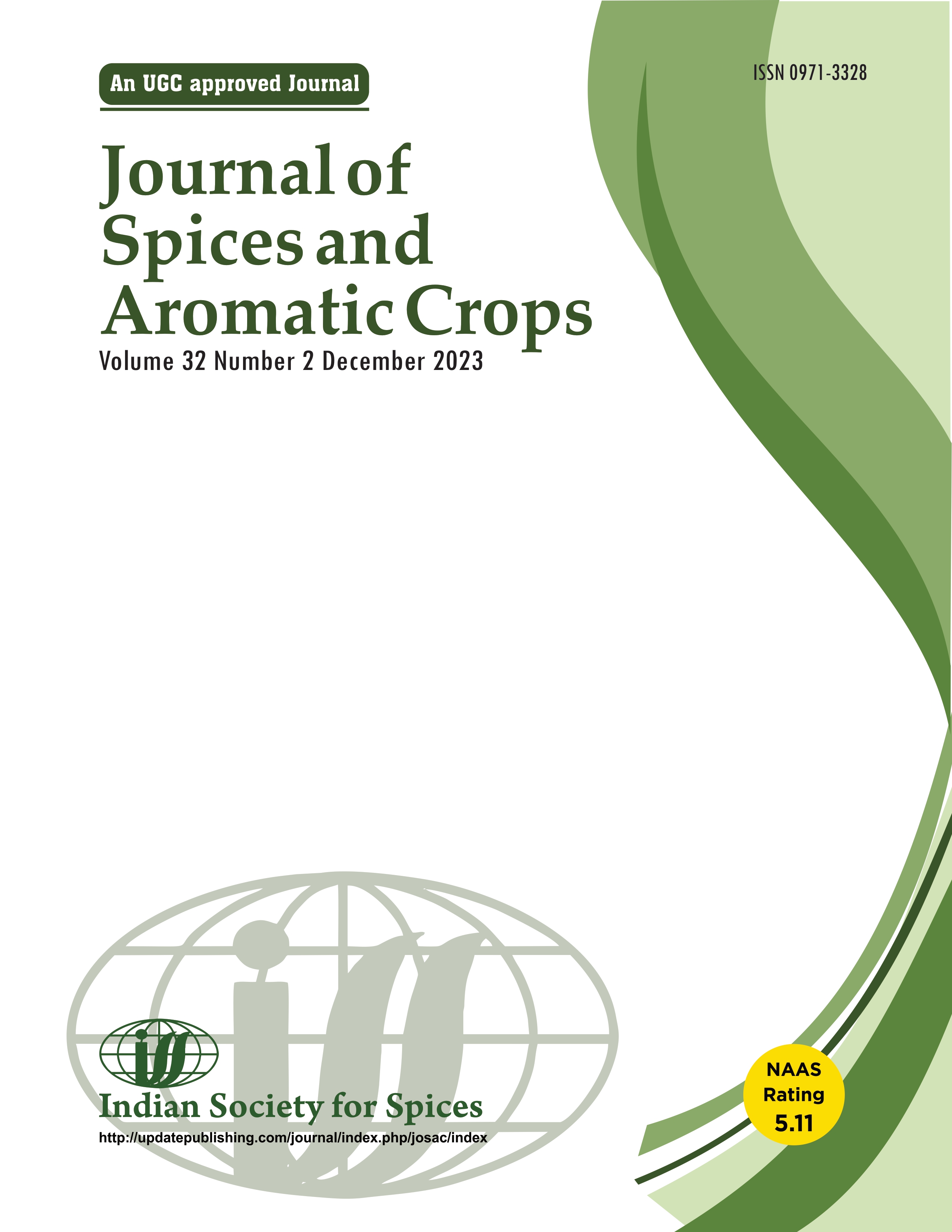Productive and profitable black pepper based mixed cropping systems involving tuber crops
Black pepper based mixed cropping systems
DOI:
https://doi.org/10.25081/josac.2023.v32.i2.8877Keywords:
Black pepper, mixed cropping systems, tuber crops, intercrops, yield, economicsAbstract
An experiment on pepper based mixed cropping systems involving tuber intercrops was carried out at Pepper Research Station (Kerala Agricultural University), Panniyur, Kannur during 2013-14 to 2022-23. Five different black pepper based mixed cropping systems which accommodated five different tropical tuber crops were experimented. The data pertaining to 2020-21, 2021-22 and 2022-23 were separately recorded and the pooled mean worked out for individual crop yields as well as equivalent yields and economics of cultivation of the different systems. The pooled equivalent yield for black pepper + greater yam and black pepper + elephant foot yam mixed cropping systems were recorded in terms of base crop black pepper as 1239.28 and 1214.25 kg ha-1 respectively, significantly superior to all other mixed cropping systems. The equivalent yield recorded for black pepper sole cropping was 561.73 kg ha-1 only. The pooled data revealed higher profitability for black pepper + greater yam mixed cropping system with gross returns, net returns and B:C ratio of Rs. 619637 ha-1, Rs.440043 ha-1 and 3.45 respectively. For black pepper + elephant foot yam system, the respective values were Rs. 607126 ha-1, Rs. 440043 ha-1 and 3.57. The soil properties were also favourably maintained under mixed cropping as that in sole cropping of black pepper as indicated by soil nutrient analysis conducted at the end of the field experiment.
Downloads
References
Anju L, Ambily P G, Gopikrishna V G & Amalraj M 2014 A study on the scope and importance of tuber crops with special reference to cassava as resilient crop towards climate change. J. Earth Sc. and Clim. Change 5 (6): 1–6.
Byju G & Neduncheziyan M 2004 Potassium: A key nutrient for higher tropical tuber crops production. Fert. News 49 (3): 39–44.
Degri M M & Ayuba J 2016 Effect of Pepper and Cereals Intercropping in the Management of Aphids (Aphis gossypii Glove) on Pepper (Capsicum annuum L.). International Journal of Research in Agriculture and Forestry 3 (4): 23–27.
Department of Economics and Statistics 2021 10th Agricultural Census 2015-16 (Report). Govt. of Kerala, 150p.
George C, Mammen P C, Chandran M S S & Thomas B 2017 Climate variability in Kerala in recent years. Institute for Climate Change Studies, Kottayam, Kerala. pp.160 (ISBN 9788193534403).
Kamal Kant, Sanjeev Kumar Gupta S K, Pathak, Ghanshyam, Amit Kumar, Sanoj Kumar, Patil S, Patel A B & Sohane R K 2020 Impact of varietal replacement demonstration on the yield and economics of elephant foot yam (Amorphophallus paeoniifolius) cv. Gajendra in Bhagalpur District of Bihar. Int. J. Curr. Microbiol. App. Sci. 9(2): 1849–1855.
KAU 2016 Package of Practices Recommendations: Crops (15th Ed.). Kerala Agricultural University, Thrissur, 393p.
Laszlo M 2010 Effect of Fertilisation on Potato (Solanum tubersosum L.) Quality. In: Proceedings of the EGU General Assembly held from 2-7 May, 2010 in Vienna, Austria, p.2835.
Sahoo B, Nedunchezhiyan M & Acharya P 2015 Productivity potential of elephant foot yam (Amorphophallus paenifolius (Dennst.) Nicolson) in alfisols as influenced by fertility levels. The Bioscan 10 (3): 1255–1257.
Subramanian P, Maheswarappa H P, Zachariah T J, Surekha R, Selvamani V & Ravi Bhat 2016 Performance of black pepper in coconut based high density multi-species cropping system under different nutrient managements. J. Plantation Crops 44(2): 90–95.
Thankamani C K, Kandiannan K, Madan M S, Raju V K, Hamza S & Krishnamurthy K S 2011 Crop diversification in black pepper grown with tuber and fodder crops. J. Plantation Crops 39 (3): 358–362.
Thankamani C K, Kandiannan K & Hamza S 2012 Intercropping medicinal plants in black pepper. Indian J. Hort. 69 (1): 133–135.
White Ph J 2013 Improving K acquisition and utilization by crop plants J. Plant Nutr. Soil Sci. 176: 305–316.
Van N C, Schönfeldt N H, Hall & Pretorius B 2016 The role of biodiversity in food security and nutrition, a potato cultivar case study. Food Nutr. Sci.7: 371–382.
Published
How to Cite
Issue
Section
Copyright (c) 2023 B Sudha, C K Airina, C K Yamini Varma, C K Thankamani, K S Krishnamurthy, Sharon Aravind

This work is licensed under a Creative Commons Attribution-NonCommercial-NoDerivatives 4.0 International License.






 .
.